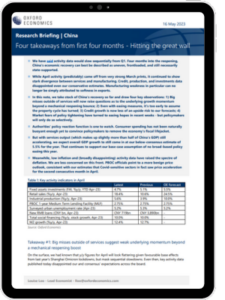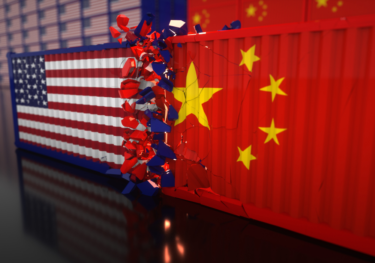China: Four takeaways from first four months – Hitting the great wall

We have said activity data would slow sequentially from Q1. Four months into the reopening, China’s economic recovery can best be described as uneven, frontloaded, and still necessarily state-supported.
While April activity (predictably) came off from very strong March prints, it continued to show stark divergence between services and manufacturing. Credit, production, and investments data disappointed even our conservative estimates. Manufacturing weakness in particular can no longer be simply attributed to softness in exports.
In this note, we take stock of China’s recovery so far and draw four key observations:
- Big misses outside of services will now raise questions as to the underlying growth momentum beyond a mechanical reopening bounce
- Even with easing measures, it’s too early to assume the property cycle has turned
- Credit growth is now less of an upside risk to our forecasts
- Market fears of policy tightening have turned to easing hopes in recent weeks – but policymakers will only do so selectively
Tags:
Related posts

Post
How Asia’s supply chains are changing | Techonomics Talks
Global supply chains have continued to expand, despite talk of deglobalization and nearshoring. US and Japan have started to de-couple from China, but other G7 countries grow more dependent on Chinese inputs. Several "hotspots" are emerging across Asia with multiple winning formulas.
Find Out More
Post
China decoupling – how far, how fast?
Economic decoupling from China is ongoing, but the latest evidence suggests that, especially outside the US, the process is gradual and piecemeal. Trade decoupling may be slowly spreading from the US to other advanced economies, however surveys suggest foreign investors' attitudes to China improved slightly in 2023, though they are still more negative than a few years ago.
Find Out More
Post
Promising trends signal optimism for the hotel sector
The global travel recovery took great strides in 2023, with some destinations already reporting a full recovery back to pre-pandemic levels. Trends continue to suggest further growth in tourism activity going into this year, signalling optimism for the hospitality sector going forward. But risks stemming from inflation, geopolitical tensions and climate change will persist.
Find Out More